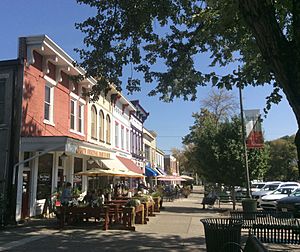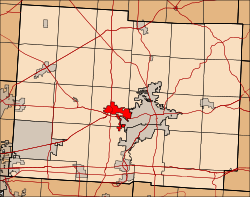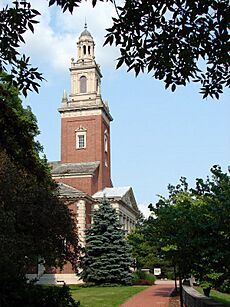Granville, Ohio facts for kids
Quick facts for kids
Granville, Ohio
|
|
|---|---|
|
Village
|
|

Granville streetscape
|
|
| Motto(s):
"One of Ohio's Best Hometowns"
|
|

Location of Granville, Ohio
|
|

Location within Licking County
|
|
| Country | United States |
| State | Ohio |
| County | Licking |
| Area | |
| • Total | 4.86 sq mi (12.58 km2) |
| • Land | 4.81 sq mi (12.46 km2) |
| • Water | 0.05 sq mi (0.12 km2) |
| Elevation | 997 ft (304 m) |
| Population
(2020)
|
|
| • Total | 5,946 |
| • Estimate
(2023)
|
6,281 |
| • Density | 1,236.43/sq mi (477.36/km2) |
| Time zone | UTC-5 (Eastern (EST)) |
| • Summer (DST) | UTC-4 (EDT) |
| ZIP code |
43023
|
| Area code(s) | 740 |
| FIPS code | 39-31402 |
| GNIS feature ID | 2398193 |
Granville is a small village in Licking County, Ohio, United States. In 2020, about 5,946 people lived there. It is in a hilly, rural area of central Ohio.
Granville is about 35 miles (56 km) east of Columbus, the state capital. It is also 7 miles (11 km) west of Newark, which is the county seat.
The village was first settled by European-Americans from Wales. It has always been an important center for education. Granville was also a key place for the Temperance Movement and the Abolitionist movement.
Today, Granville is home to Denison University. The village has many old and beautiful buildings. These include Greek Revival style homes like the Avery Downer House. St. Luke's Episcopal Church (built in 1837) is another example. Other famous spots are the Buxton Inn (1812), the Granville Inn (1924), Bancroft House (1834), and Bryn Du Mansion.
Contents
History of Granville
Ancient Cultures in Granville
Granville is home to the Alligator Effigy Mound. This ancient mound was built by the Fort Ancient culture. They lived here between 800 and 1200 CE. This was hundreds of years before Europeans arrived.
The mound might look like an effigy (a shape or image) of an "underwater panther." This creature is part of Native American stories. The Alligator Effigy Mound is a protected historic site.
The area around Granville has many signs of ancient cultures. The Newark Earthworks are less than five miles away. These earthworks were built by the Hopewell culture. They lived here from about 100 BCE to 500 CE.
Pioneer Settlers Arrive
European Americans first settled Granville in 1805. The first large group came from a town called Granville, Massachusetts. They named their new village after their old home.
The land was first surveyed in 1797. The United States government set it aside for soldiers. These soldiers had fought in the Revolutionary War. They were paid with land grants.
Some of the first settlers were Theophilus Rees and his son John. They came from Wales in 1795. They traveled west to start a new life. They arrived in what is now Granville in 1802. Many other Welsh settlers followed them. This is why many places in the area have Welsh names.
Early Schools and Education
Education was very important to the early settlers. By 1820, they built a three-story brick school house. By the 1830s, there were five schools in the growing village.
Over time, these schools grew and served students from the whole region. Some of these early schools included:
- Granville Literary and Theological Institution
- Granville Female Seminary
- Granville Episcopal Female Seminary
- Young Ladies’ Institute
- Granville Female Academy
- Doane Academy (named after William Howard Doane, a generous supporter of Denison University)
- Shepardson College for Women
Many of these schools were "preparatory schools." This means they prepared students for college, much like high schools today. It was a time when educating girls became very important. Granville made sure its young women could get an education. Several of these schools later joined together to become what is now Denison University.
Granville's Geography
Granville covers about 4.71 square miles (12.20 square kilometers). Most of this area is land, with a small amount of water.
The center of the village is surrounded by three important hills:
- College Hill is to the north.
- Sugarloaf is a well-known hill and park on the west side of Broadway.
- Mt. Parnassus is another important hill and living area on the east side of Broadway.
South of the village center is the Raccoon Creek. This creek flows from west to east.
Population Information
| Historical population | |||
|---|---|---|---|
| Census | Pop. | %± | |
| 1820 | 199 | — | |
| 1830 | 362 | 81.9% | |
| 1840 | 727 | 100.8% | |
| 1850 | 771 | 6.1% | |
| 1860 | 801 | 3.9% | |
| 1870 | 1,109 | 38.5% | |
| 1880 | 1,127 | 1.6% | |
| 1890 | 1,366 | 21.2% | |
| 1900 | 1,425 | 4.3% | |
| 1910 | 1,394 | −2.2% | |
| 1920 | 1,440 | 3.3% | |
| 1930 | 1,467 | 1.9% | |
| 1940 | 1,502 | 2.4% | |
| 1950 | 2,653 | 76.6% | |
| 1960 | 2,868 | 8.1% | |
| 1970 | 3,963 | 38.2% | |
| 1980 | 3,851 | −2.8% | |
| 1990 | 4,244 | 10.2% | |
| 2000 | 3,167 | −25.4% | |
| 2010 | 5,646 | 78.3% | |
| 2020 | 5,946 | 5.3% | |
| 2023 (est.) | 6,281 | 11.2% | |
| Sources: | |||
Population in 2010
In 2010, there were 5,646 people living in Granville. There were 1,441 households. About 36.8% of these households had children under 18. Most households (59.3%) were married couples.
The average age in the village was 22 years old. About 18.1% of people were under 18. Many residents (38.7%) were between 18 and 24 years old.
Culture and Community
Religion in Granville

Granville has a long connection with the American Baptist Church in Ohio. The main office for the American Baptist Churches of Ohio is still in the village.
Denison University was started as a Baptist college. Over time, its religious ties became less strong. Today, Denison is a non-religious university.
Education in Granville
Village Schools
Granville has its own public school system. It is called the Granville Exempted Village School District.
The schools include:
- Granville High School
- Granville Middle School
- Granville Intermediate School
- Granville Elementary School
The high school's class of 2014 had 220 students. The Ohio Department of Education gives the district high ratings.
Granville also has the Granville Christian Academy. This school serves students from kindergarten through 12th grade. There are also several private preschools.
Denison University
Denison University is on a hill overlooking the village. It was founded in 1831. It started as the Granville Theological and Literary Seminary. It was connected to the Northern Baptist Convention.
Today, Denison is a private college. It focuses on liberal arts. About 2,300 students attend the school. There are 235 teachers.
Denison offers Bachelor of Arts, Bachelor of Science, and Bachelor of Fine Arts degrees. Many students (74%) come from outside Ohio. Students from forty different countries also attend.
The Homestead at Denison University is a special living area for students. They focus on environmental sustainability.
Swasey Chapel is a famous building on campus. It was finished in 1924. The chapel is named after Ambrose Swasey. He was a generous supporter of the college. He was also a well-known inventor and businessman from Cleveland.
The history of Granville and Denison University are closely linked. Many university staff and teachers live in the village. Students also support many local businesses. Granville residents can use many university facilities for free. The college has also bought local places like the Granville Golf Club and the Granville Inn.
Famous People from Granville
- Hubert Howe Bancroft, a historian and expert on cultures.
- Ernest DeWitt Burton, a Bible scholar and president of the University of Chicago.
- Paul Carpenter, a minor league baseball player.
- Edward Andrew Deeds, an inventor and business leader.
- Edmund Burke Fairfield, a minister, educator, and politician.
- Lottie Estelle Granger, an educator.
- Marie Harf, a political commentator and former government advisor.
- Ellen Hayes, an astronomer and mathematician.
- Woody Hayes, a football coach for Denison University and Ohio State University.
- George Jones, who helped start the New York Times newspaper.
- Rob Mounsey, a composer and music arranger.
- Lea Ann Parsley, an Olympic silver medalist in skeleton at the 2002 Winter Olympics.
- Marcus Aurelius Root, a leading photographer and author.
- Alan Schaaf, who created the image sharing website Imgur.
- Brian Unger, named one of Entertainment Weekly's "100 Most Creative People in Entertainment."
- Willard Warner, a brigadier general in the Union Army during the American Civil War.
- Scott Wiper, a writer and director.
See also
 In Spanish: Granville (Ohio) para niños
In Spanish: Granville (Ohio) para niños


